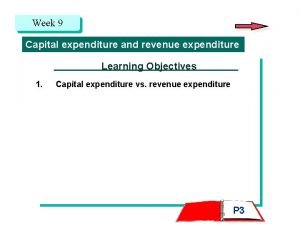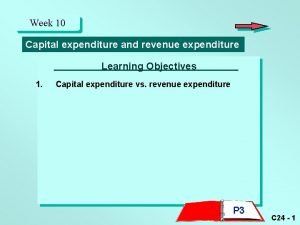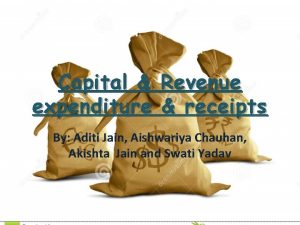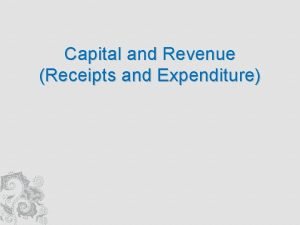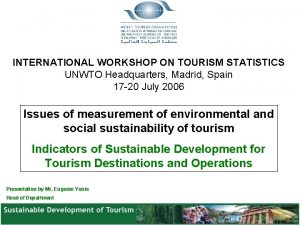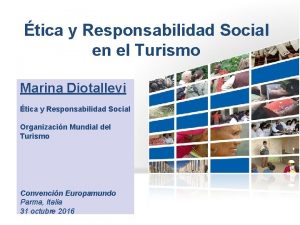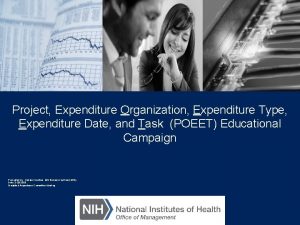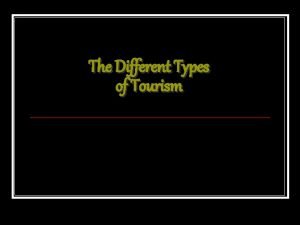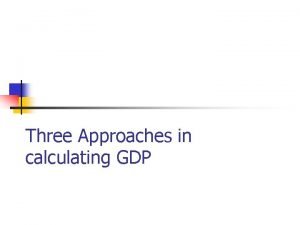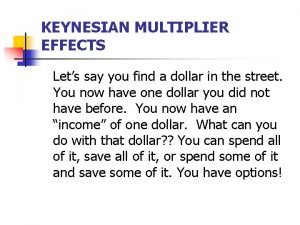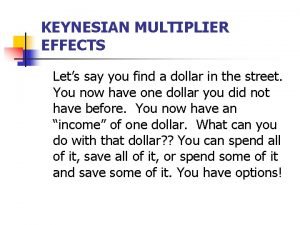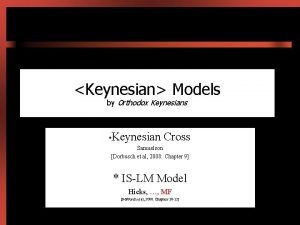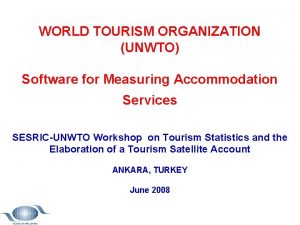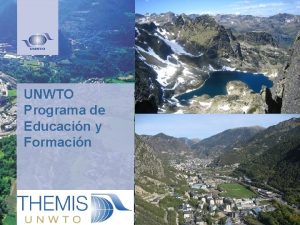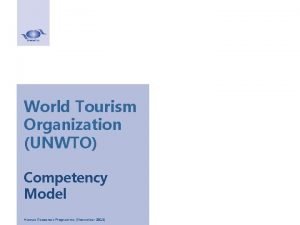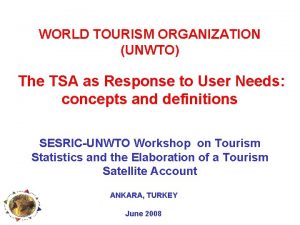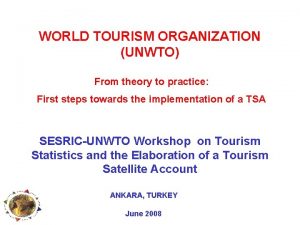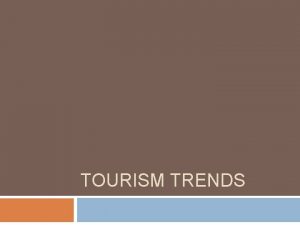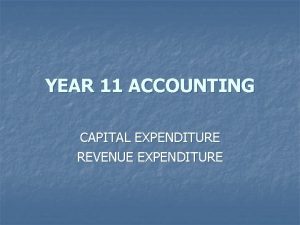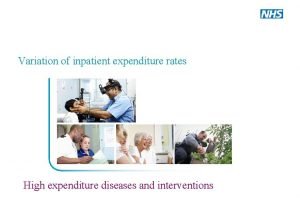WORLD TOURISM ORGANIZATION UNWTO MEASURING TOURISM EXPENDITURE A



















- Slides: 19

WORLD TOURISM ORGANIZATION (UNWTO) MEASURING TOURISM EXPENDITURE: A UNWTO PROPOSAL SESRIC-UNWTO WORKSHOP ON TOURISM STATISTICS AND THE ELABORATION OF A TOURISM SATELLITE ACCOUNT ANKARA, TURKEY June 2008 1

General background • This project called “Research on international experiences in measuring tourism expenditure associated with inbound tourism” was co-funded by Canada, Spain, Sweden and WTO and developed by the firm Araldi. • It develops an original method to compare the national experience of eight different countries, covering not only their questionnaire but also the genral methodology of the survey. • From this comparison, it is possible to deduct a basic recommended questionnaire and draw methodological recommendations for general purposes. 2

Objectives - to enhance the credibility of the measurements of the economic importance of tourism; - to improve comparability between countries by providing them with common statistical tools to measure them; - to promote the collection of robust information and indicators of a monetary nature. - To present national experiences and best practices, for countries to adapt to their own national needs. - to establish a more clear relationship between the estimated tourism expenditure and the characteristics of the trip, with two objectives: - To improve the estimation of expenditure through the use of defined attributes related to it; - To serve the needs of marketing 3

Results • First result : a framework of analysis of the questionnaires used by each country presented in comparative formats and tabular form: A methodology of analysis • Second result : a descriptive document presenting in a homogeneous and comparative form the methodologies that were used in the 8 countries under study and incorporating aspects that were common to the different countries while maintaining the records that were specific to each of them. A uniform description of the practice of 8 countries • Final result and based on this general framework, a proposed basic questionnaire on tourism expenditure for inbound tourism as well as the corresponding general guidelines for its implementation: a general recommendation ref: (www. world-tourism. org/statistics/tsa project/Visitor expenditure en la web/WTO Proposal. pdf) 4

The recommendations • Model Questionnaire • General Recommendations – – – Interinstitutional Cooperation Setting up a method of observation Survey design The universe of reference General problems related to the survey Comparison of the results with those obtained through different procedures – Etc. 5

The model questionnaire: what to expect from it • More than its specific arrangement and content, it is: – The organization as referred to other surveys: • Possibility to relate to a separate measure of flows of travellers; • Possibility to relate to other observations on the trips and the travellers; – The general scope of the questionnaire 6

THE QUESTIONNAIRE • 5 block, each covering a specific objective • Block A. Travelers • Block B. Means of transport • Block C. About your stay • Block D. Trip/visit organization & expenditure before leaving your country of residence • Block E. Expenditure in our country 7

Some previous remarks • The questionnaire has been designed for its implementation at national borders, to be directed to non-residents at the time of departure from the country visited. (it can also be adjusted to be used for returning outbound visitors). • The questionnaire should be applied through personal interviews. • Unlike other surveys, once the interview concludes it will be very difficult to contact again with the respondent to correct inconsistencies or complete partial information. • The questionnaire takes into consideration all expenditure associated to the trip, irrespective of who paid for it. 8

Block A. The traveller • • • Location of the survey; (Q. 1) Date of departure ; (Q. 2) Nationality ; (Q. 3) Country of residence ; (Q. 4) Group (event. ) and size of the group (Q. 5, Q. 6) • Means of transport to leave the country ; (Q. 7) 9

Block B. Means of transport • Precise identification; (Q. 8, Q. 9, Q. 11, Q. 12): – Different questions according to the means of transport used • Final destination ; (Q. 10) • Other countries visited; (Q. 13) 10

Bloc C. About your stay • Date of arrival and conditions; (Q. 14 -Q. 17) • Length of stay (Q. 18) • Purposes of the visit (Q. 19, Q. 20, Q. 22, Q. 23)) • Frequency of visits (Q. 21) • Place visited/ types of accommodation (Q. 24) • Activities undertaken during the stay (Q. 25) 11

Block D. Trip/visit organization & expenditure before leaving your country of residence • Determination of the group of reference for the expenses (Q. 26) • Eventually, components of the package tour (Q. 27 -Q. 33) • Total amount and components of the expenditure before leaving the country of residence; modes of payments (Q. 34) – Transportation services – Accommodation services – Other services 12

Block E. Expenditure in our country • Global amount of expenditure (Q. 35) • Transportation expenditure (Q. 35. 1) – In order to enter the country (Q. 35. 1. 1) – Within the country (Q. 35. 1. 2) • Expenditure in accommodation and modes (Q 35. 2) • Other expenditures (Q. 35. 3) This block is very general and only gives an insight into the global structure of expenditure 13

THE GENERAL GUIDELINES FOR ITS IMPLEMENTATION • Aspects analysed: • Interinstitutional cooperation • General approach to the survey design • Sample design: possible variability according to border post and means of transport • The universe • Implementing the questionnaire • General problems associated to the survey • Comparison of the information obtained through this procedure and through other procedures 14

The expansion framework • The reference population or expansion framework will be the total number of non-resident arrivals at the different borders points classified by main characteristics. • For an optimum expansion of the results at least the following variables should be identified within the universe: – – – means of transport, type of visitor, country of residence, purpose of the visit and period of the year. • Those variables ensure the necessary link with the variables collected in Blocks A, B and C of the basic questionnaire. The project presented as “measuring international flows of travellers at national borders” will provide the required 15 recommendations for the definition of this framework

Statistical sample design • Objective: – To determine the size of the sample and its distribution; • Geographically • Temporally (during the day/over the year) • Consideration of the degree of heterogeneity of some populations • All attributes of the variables concerning travelers which require to be analyzed have to be represented in a statistically significant mode (implications on the size of the sample) ; • The sample design will vary according to the means of access (road, water, air, etc…) and the port of entry 16

The pilot survey • test the questionnaire and to check different potential sources for sampling and non sampling errors such as – the place and method in which the surveys are carried out, – the identification of any omitted answers and the reason for the omission, problems of communication, – organization of the field work, – translation, etc. . • Being a border survey it is necessary to analyse carefully certain aspects as: – selecting and capturing potential respondents and selecting them according to the sample design, – choosing the best survey areas, – organizing field work at geographically distant points, securing the collaboration of the institutions responsible for border traffic control, – establishing the data collection mechanism, etc. . 17

Comparison of the information with that coming from other related sources • Once the survey process has begun a comparison of the information collected at some basic levels is necessary: • Internal comparison of the sample information to detect any outlyer data, inconsistent answers, etc. • Comparisons between the information available on the population of reference (i. e. arrivals figures provides by the border control) and that provided by the survey at a sample level in order to detect any biases. • Comparison of the results obtained in the survey on expenditure with that from other sources (i. e. sources used by the Central Bank to estimate the “Travel” item of the Balance of Payments). 18

Importance of this proposal within the setting up of the general statistical system of a country • Collecting this type of information is not only important for studies on tourism – Use of its results for Balance of Payments purposes; – Use of its results for National Accounting purposes; Based on this type of concern and experience, WTO has been asked to make proposals in order to improve the definition and the measurement of the travel item of the Balance of Payments: introduction of this methodological proposal in the future Bo. P compilation guideline of the revised Bo. P. 19
 Revenue expenditures
Revenue expenditures Revenue expenditure
Revenue expenditure Meaning of revenue expenditure
Meaning of revenue expenditure Features of capital receipts
Features of capital receipts Definizione turismo unwto
Definizione turismo unwto Unwto headquarters
Unwto headquarters Que significa unwto
Que significa unwto Nvision nih
Nvision nih Mass tourism vs alternative tourism
Mass tourism vs alternative tourism Process organization in computer organization
Process organization in computer organization Block organization vs point by point
Block organization vs point by point Is travel the largest industry in the world
Is travel the largest industry in the world Personal income formula
Personal income formula Government expenditure multiplier formula
Government expenditure multiplier formula Formula to find gdp
Formula to find gdp Final expenditure approach
Final expenditure approach Tax multiplier formula
Tax multiplier formula Multiplier effect formula
Multiplier effect formula Autonomous expenditure formula
Autonomous expenditure formula Tax multiplier formula
Tax multiplier formula
